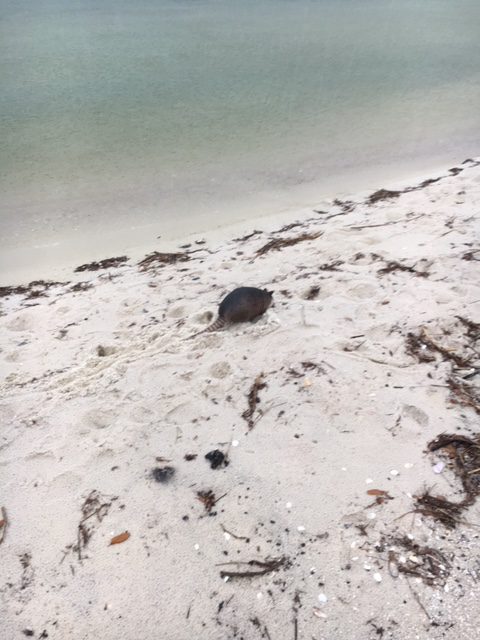Florida has a love-hate relationship with this animal. Some find them cute and adorable, others find them a pest and a nuisance, either way there is no ignoring this guy. They are everywhere and yes – they can make a mess of your lawn and garden. So, for those who are not so in love with the creature – what can be done?
Let’s first meet the animal.
There are about 20 species of armadillo found in Central and South America but there is only one in the U.S., the Nine-Banded Armadillo (Dasypus novemcinctus). The Nine-Banded Armadillo is originally from South America and there were several different species of armadillos that made the trek from South to North America prior to the ice age. But after the ice age it seemed no armadillos were present in the U.S. After the ice age, the Nine-Banded Armadillo expanded north into Mexico, but it seems could not cross the Rio Grande. That is until Americans began to settle the area. Prior to American settlement, armadillos were hunted for food, and the land on both sides of the river was regularly burned. The American settlers ceased the burning and the Native Americans declined in numbers, so hunting pressure declined as well. Many armadillos were probably brought across intentionally, but others who managed to swim across, and armadillos can swim, now found suitable habitat with the decreased burning. They had arrived and began expanding both east and west across the southern U.S. However, the Mississippi River presented another barrier they could not deal with.

Photo: Rick O’Connor
The introduction in Florida was a different story. Apparently in the 1920s and 30s they were released by humans. One release appeared to be an escape from a small zoo. Another was from a circus. There are reports of armadillos riding cattle cars on trains from the west and this allowed them to cross the Mississippi. In the 1920s bridges were built across the river for a new invention called the automobile. All of this led to the invasion and the animals are now here, they are also expanding north.
Armadillos like warm/wet climates. They prefer forested areas or grasslands and, again, can swim small rivers and creeks easily. It has been reported they can hold their breath up to six minutes and have been seen literally walking along creek bottoms.
They feed primarily on a variety of small invertebrates such as grubs, snails, beetles, and even cockroaches (many of you will like that). They like to feed in wet areas or loose sandy soils where digging is easier. Unfortunately, your lawn is a good place to hunt. They rarely, but do, feed on small reptiles and amphibians and eggs.
They breed in the summer but delay egg implantation so that birth is in the spring. They typically give birth to quadruplets. The armor of the young is not hard at first but hardens over time and does provide protection from large predators like panthers, bears, and alligators. They typically live 12-15 years, but some have reached the age of 20.
So… now you know the animal… for those who do not want them, what can be done?
Based on an article from UF IFAS Extension, not a lot. Typical methods of deterring wildlife have not worked. Poisons, smells, and even using firearms has not relieved the homeowner of the problem. One study looked at trapping and found that in general it is hard to get them to enter. In this study they caught one armadillo every 132 trap nights – low percentages. Another study looked at baits and found crickets and worms worked best, but the smell of other armadillos in the trap also lured them. One colleague mentioned the need for solid wood traps and he baits them with nothing but the shells of roadkill as had good success. He mentioned the designs of these wooden traps are online. You can get plans to build them, and you can also purchase pre-made ones. Once captured they can be relocated but the trapper should be aware that armadillos have many peg-like teeth and very sharp claws for digging. HANDLE WITH CARE. It is also known that armadillos can carry leprosy, though cases of leprosy being transmitted to humans are rare. None the less, handle with care.
For more information on this animal, contact your county extension office.
 3
3
